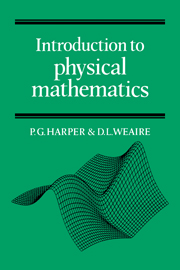Book contents
- Frontmatter
- Contents
- Preface
- Some notes on notation
- 1 Introduction
- 2 Errors
- 3 Cartesian coordinates
- 4 Vectors
- 5 The scalar product
- 6 The vector product and rotation
- 7 Matrices in physics
- 8 The transformation of matrices
- 9 The matrix eigenvalue equation
- 10 Exponential and logarithm functions
- 11 Sine and cosine functions
- 12 Graph plotting and curve sketching
- 13 Differentiation
- 14 Approximations
- 15 Power series and Taylor's expansion
- 16 Partial differentiation
- 17 Integration
- 18 The differential equation
- 19 Solving first-order differential equations
- 20 Second-order differential equations
- 21 Solving second-order differential equations
- 22 The complex exponential
- 23 The circuit equation
- 24 Harmonics and Fourier series
- 25 The diffusion equation
- 26 Waves
- 27 The rate of change of a vector
- 28 The scalar field and gradient operator
- 29 The vector field
- 30 Line integration
- 31 The potential field
- 32 Surface and volume integration
- 33 Flux and divergence
- 34 Circulation and the curl
- 35 Conclusion
- 36 Miscellaneous exercises
- Index
21 - Solving second-order differential equations
Published online by Cambridge University Press: 20 October 2009
- Frontmatter
- Contents
- Preface
- Some notes on notation
- 1 Introduction
- 2 Errors
- 3 Cartesian coordinates
- 4 Vectors
- 5 The scalar product
- 6 The vector product and rotation
- 7 Matrices in physics
- 8 The transformation of matrices
- 9 The matrix eigenvalue equation
- 10 Exponential and logarithm functions
- 11 Sine and cosine functions
- 12 Graph plotting and curve sketching
- 13 Differentiation
- 14 Approximations
- 15 Power series and Taylor's expansion
- 16 Partial differentiation
- 17 Integration
- 18 The differential equation
- 19 Solving first-order differential equations
- 20 Second-order differential equations
- 21 Solving second-order differential equations
- 22 The complex exponential
- 23 The circuit equation
- 24 Harmonics and Fourier series
- 25 The diffusion equation
- 26 Waves
- 27 The rate of change of a vector
- 28 The scalar field and gradient operator
- 29 The vector field
- 30 Line integration
- 31 The potential field
- 32 Surface and volume integration
- 33 Flux and divergence
- 34 Circulation and the curl
- 35 Conclusion
- 36 Miscellaneous exercises
- Index
Summary
In this chapter we shall first reflect upon the procedure for solving second-order differential equations numerically, just as we did with first-order equations. Indeed, the obvious method is closely similar. For simplicity, we shall focus on the oscillator equation (20.6). Again we shall temporarily disregard the fact that our chosen equation has a simple analytic solution. This is ‘simple harmonic motion’, x = A sin (ωt + B) or C sin ωt + D cos ωt. Instead we shall ask how we would set about solving it numerically as there are some general lessons to be learned from this. Let us try to find the analogue for second-order equations of Euler's method already studied for first-order equations. Again we shall choose convenient numerical values for purposes of illustration, so we take ω2 = 4 and will look for a solution in the range t = 0 to t = 4.
We shall try to find this by a step-by-step procedure, with a steplength Δt = 0.1. But again we need a ‘jumping-off point’ – some starting information. If we are given, say, x = 1 at t = 0 we can use the differential equation to get d2x/dt2 at t = 0, but this is not enough information to make the required step. We need to be given (or choose) a starting value for dx/dt, say 2, as well, and use two equations to get started.
- Type
- Chapter
- Information
- Introduction to Physical Mathematics , pp. 147 - 152Publisher: Cambridge University PressPrint publication year: 1985



